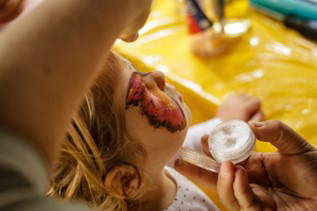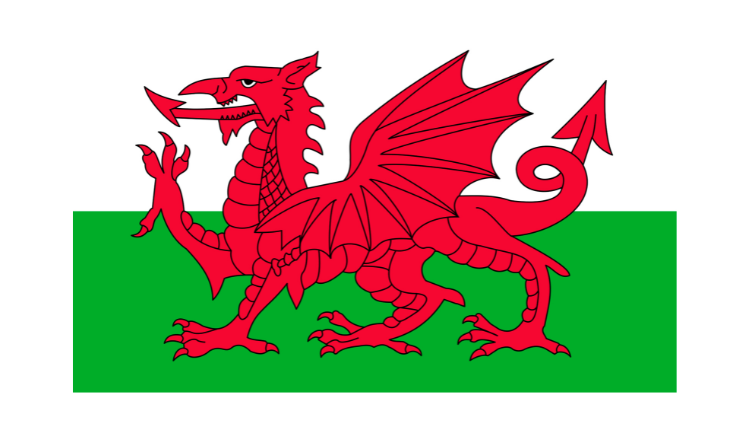PACEY
There is huge potential for using face painting as a way of supporting children’s learning, development and play. As practitioners, we need to explore the safety considerations and risk assessments associated with a face painting activity.
Children use play to explore and build on their current interests. It is beneficial to offer additional invitations to play and acknowledge that children want to explore, create, and “act out” what they are learning, even though they are very skilled at using the resources and the environment around them to create their own play.
Face painting can be used to create stories and narratives. The children’s faces can become the characters from fairy tales to adventures in space. Face painting can spark children’s imagination and creativity.
Some of the benefits of face painting in the early years include:
- Supporting social and emotional well-being
- Facilitating social interaction
- Building self-confidence and self esteem
- Enhancing creativity and imagination
- Supporting children to develop a positive self-identity

How to introduce face painting in your setting
Dolls
Using a Tuff-Tray, set the dolls up with face painting pallets, brushes, sponges and water. Let the children explore the invitation to play and get creative!
Role play
Display face painting pallets near the role play area. Put out sponges, brushes, clean water and a mirror. You could start with primary colours, teaching the children to identify the colour and pronounce their name, you can introduce incidental Welsh here too! Along with any other languages spoken at home or in the setting. You can role-model colour mixing to create new shades of colour to paint on their faces. Letting the children lead their play and ‘learn through doing’ will develop their understanding of colour and improve their language and vocabulary skills.
Thematic learning
Do you introduce themes within your setting? Face painting can enhance play activities and provide the ideal opportunity to talk about your current theme! A jungle theme can come to life with face painting when some monkeys arrive with lions and leopards close behind. Children may ask for more spots than their friend, or an extra stripe, this will encourage language development.
Consider the materials and resources that you will need
- Brushes
- Fresh clean sponge and brushes per child
- Regular clean water
- Mirror
- EU and FDA compliant Professional Face Paints
- Policy on who should not be face painted
- Policy on painting children with dirty faces or skin conditions
- Good practice in health and hygiene
Think about your risk assessment
- Before introducing face paints within your setting, ensure that you discuss this with parents, have written parental permission in place and checked on any health considerations. PACEY guidance for risk assessments and parental permission forms can be found in the links section below.
- If you are bringing in a professional face painter, it is important to ensure that they are trained and/or have an association membership, and to ensure they have risk assessments and Public Liability Insurance in place. For more information on association membership, you could look at FACE.
- Be wary when applying paint around the eyes, especially if you’re allowing children to paint themselves; ensure sponges and brushes are washed after each ‘face’; and be aware of any broken skin, infections, or any allergies before starting. Parental permission will be needed too.
- Face paints, like any cosmetic product, may cause a reaction to those who have sensitive skin. If you have any concerns as to how a child’s skin may react, you could, with parental permission, carry out a patch test on the child’s skin beforehand? More information on patch testing can be found on the Allergy UK website by scrolling down the information at Allergy to Cosmetics.
- Children with skin allergies or sensitive skin should either not participate or have a member of staff perform a patch test on the arm before painting the child’s face. You will need to consider not painting anyone who is or appears to be sick or suffering from cold sores, conjunctivitis, ringworm, sunburn, eczema, any infectious skin condition, or open wound.
- Never use the same sponge or brush on more than one child. Using the same sponge or brush on multiple children puts them at risk to the spread of bacterial, viral and fungal infection, as well as other skin-borne infestations.
- Sponges should be washed in a net bag in a hot wash at least 60° C degrees.
- Brushes should be washed thoroughly at the end of each session using a brush and soap and allowed to air dry.
- A water spray should be used for sponges to avoid putting the sponge in the brush water; this will help keep paints and equipment cleaner as well as controlling the consistency of sponged paints. Fresh water should be used for each child’s brushes and sponges.
- It is not recommended that children under the age of 3yrs are painted on the face, as per the manufacturer’s guidelines.
- Many younger children may not understand that the paint is temporary and can become frightened and distressed on feeling and seeing their face painted. For this reason, only paint children who can indicate their wish to be painted.
Signposts
- Allergy to Cosmetics, Allergy UK
- Code of Practice – FACE, The International Face Painting Association (FACE)
- Risk assessment, PACEY member resource
- Curriculum for Wales, PACEY Spotlight page (Wales only)
- Early years foundation stage (EYFS) statutory framework, Department for Education
- Sample policies (England), PACEY members in England can access sample policies and parental permission forms for childminders
- Policy guidance (Wales), PACEY members in Wales can access guidance for writing and reviewing risk assessments and parental permission forms


